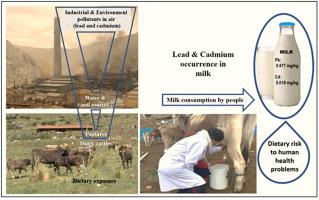Ecotoxicology and Environmental Safety ( IF 6.8 ) Pub Date : 2021-06-02 , DOI: 10.1016/j.ecoenv.2021.112382 Jorge Castro-Bedriñana 1 , Doris Chirinos-Peinado 1 , Elva Ríos-Ríos 2 , María Machuca-Campuzano 3 , Elvis Gómez-Ventura 4

|
The mining-metallurgical industry in the central Andes of Peru is a source of lead (Pb) and cadmium (Cd) contamination in milk, and there are no studies on the impact of their ingestion. Using flame atomic absorption spectrometry, we quantified the concentration of these metals in raw milk produced in agroecological zones near these industries, and estimated the exposure and dietary risk in people aged 2–85 yr with minimum, average and maximum daily milk intake. In 2018, 40 raw milk samples were collected from 20 cows at two times of the year. The mean Pb and Cd concentrations were 577 ± 18.2 and 18.35 ± 5.4 μg/kg, all samples exceeded the maximum limits (ML). Children aged 2–5 and 6–15 yr, with average milk consumption, had Pb weekly intakes (WI) of 2019 and 2423 μg, exceeding the risk value; values for Cd 64 and 77 μg were below the risk values. In those older than 20 years the WI for both metals are below the risk values. The Dietary Risk Coefficient (DRC) to Pb in children younger than 8 years was >3 due to higher milk consumption in relation to body weight; for children aged 9–19 years it was 1.7 and 2.9, being <1 for those older than 20 yr. Cd RDCs were <1 at all ages, with the exception of 2-year-olds in the high milk consumption scenario (RDC > 1). There was notable evidence of Pb and Cd exposure risk from consumption of milk produced near mining-metallurgical activities, predominantly for children under 19-year-olds. In Peru there are no regulations for Pb and Cd in fresh milk and milk products, we recommended that ML for heavy metals in food be established.
中文翻译:

秘鲁中部安第斯山脉采矿冶金工业附近地区牛奶被铅和镉污染的饮食风险
秘鲁安第斯山脉中部的采矿冶金行业是牛奶中铅 (Pb) 和镉 (Cd) 污染的来源,并且没有关于摄入它们的影响的研究。使用火焰原子吸收光谱法,我们量化了这些行业附近农业生态区生产的原料奶中这些金属的浓度,并估计了 2-85 岁人群中每日牛奶摄入量最低、平均和最高的暴露和饮食风险。2018年分两次采集20头奶牛的原奶样品40个。平均 Pb 和 Cd 浓度分别为 577 ± 18.2 和 18.35 ± 5.4 μg/kg,所有样品均超过最大限值 (ML)。2-5 岁和 6-15 岁儿童,平均牛奶消费量,每周铅摄入量 (WI) 为 2019 年和 2423 μg,超过风险值;Cd 64 和 77 μg 的值低于风险值。在那些超过 20 年的金属中,两种金属的 WI 都低于风险值。由于与体重相关的牛奶摄入量较高,因此 8 岁以下儿童的膳食风险系数 (DRC) 对 Pb 的影响大于 3;9-19 岁儿童为 1.7 和 2.9,20 岁以上儿童<1。除了高牛奶消费情景中的 2 岁儿童(RDC > 1)外,所有年龄段的 Cd RDC 均小于 1。有显着的证据表明,食用在采矿冶金活动附近生产的牛奶存在铅和镉暴露风险,主要针对 19 岁以下的儿童。秘鲁没有关于鲜奶和奶制品中铅和镉的规定,我们建议建立食品中重金属的最大限量。由于与体重相关的牛奶摄入量较高,因此 8 岁以下儿童的膳食风险系数 (DRC) 对 Pb 的影响大于 3;9-19 岁儿童为 1.7 和 2.9,20 岁以上儿童<1。除了高牛奶消费情景中的 2 岁儿童(RDC > 1)外,所有年龄段的 Cd RDC 均小于 1。有显着的证据表明,食用在采矿冶金活动附近生产的牛奶存在铅和镉暴露风险,主要针对 19 岁以下的儿童。秘鲁没有关于鲜奶和奶制品中铅和镉的规定,我们建议建立食品中重金属的最大限量。由于与体重相关的牛奶摄入量较高,因此 8 岁以下儿童的膳食风险系数 (DRC) 对 Pb 的影响大于 3;9-19 岁儿童为 1.7 和 2.9,20 岁以上儿童<1。除了高牛奶消费情景中的 2 岁儿童(RDC > 1)外,所有年龄段的 Cd RDC 均小于 1。有显着的证据表明,食用在采矿冶金活动附近生产的牛奶存在铅和镉暴露风险,主要针对 19 岁以下的儿童。秘鲁没有关于鲜奶和奶制品中铅和镉的规定,我们建议建立食品中重金属的最大限量。1 为 20 岁以上的人。除了高牛奶消费情景中的 2 岁儿童(RDC > 1)外,所有年龄段的 Cd RDC 均小于 1。有显着的证据表明,食用在采矿冶金活动附近生产的牛奶存在铅和镉暴露风险,主要针对 19 岁以下的儿童。秘鲁没有关于鲜奶和奶制品中铅和镉的规定,我们建议建立食品中重金属的最大限量。1 为 20 岁以上的人。除了高牛奶消费情景中的 2 岁儿童(RDC > 1)外,所有年龄段的 Cd RDC 均小于 1。有显着的证据表明,食用在采矿冶金活动附近生产的牛奶存在铅和镉暴露风险,主要针对 19 岁以下的儿童。秘鲁没有关于鲜奶和奶制品中铅和镉的规定,我们建议建立食品中重金属的最大限量。


























 京公网安备 11010802027423号
京公网安备 11010802027423号